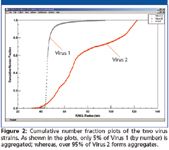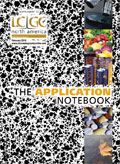Virus Particle Characterization
Viruses are packets of infectious nucleic acid (either DNA or RNA) surrounded by a protective coat consisting of a large number of protein subunits.
Viruses are packets of infectious nucleic acid (either DNA or RNA) surrounded by a protective coat consisting of a large number of protein subunits. Since viruses can cause various diseases—some life-threatening—characterizing virus particles thoroughly in terms of their size distribution, aggregation, and absolute counts-per-unit volume is of extreme importance.
Though size exclusion chromatography (SEC) has been the primary tool for separating aggregates of molecules, it is generally not appropriate for fractionating viruses because viruses and their aggregates are subject to shearing degradation by the stationary phase. Moreover, they can also be caught by the columns due to their large sizes.
The Eclipse, a particle separation system based uponFieldflow fractionation (FFF), effectively replaces SEC as a perfect alternative for virus characterization. Since it is analogous to an HPLC separation, the Eclipse—combined with MALS—makes a physical separation of the particles and then sizes them directly as they elute.
This application note reports the results obtained from a set of virus particles fractionated by Eclipse and sized by the 18-angle DAWN EOS on-line multi-angle light scattering instrument.
Figure 1 shows the radius measured by the DAWN EOS detector (from initial slope of angular dependence) versus elution time for two different virus strains. The plots show clearly that aggregates were found in both viruses and much more in Virus 2. Results from duplicate injections of Virus 1 show the excellent reproducibility of the Eclipse-MALS system.

Figure 1
The results are also shown by the cumulative number distribution plots in Figure 2. The cumulative number distribution yields quantitative information on the percentage of aggregates present in each virus strain: 5% for Virus 1 and 95% for Virus 2.

Figure 2
The success of the virus characterization demonstrated above confirms that the Eclipse-MALS approach is an indispensable tool for charactering virus particles—and other colloidal particles—in solution. This approach is especially important when the absolute particle distributions are vital.

Wyatt Technology Corporation
6300 Hollister Avenue, Santa Barbara, CA 93117
tel. (805)681-9009; fax (805)681-0123
Website: www.wyatt.com

SEC-MALS of Antibody Therapeutics—A Robust Method for In-Depth Sample Characterization
June 1st 2022Monoclonal antibodies (mAbs) are effective therapeutics for cancers, auto-immune diseases, viral infections, and other diseases. Recent developments in antibody therapeutics aim to add more specific binding regions (bi- and multi-specificity) to increase their effectiveness and/or to downsize the molecule to the specific binding regions (for example, scFv or Fab fragment) to achieve better penetration of the tissue. As the molecule gets more complex, the possible high and low molecular weight (H/LMW) impurities become more complex, too. In order to accurately analyze the various species, more advanced detection than ultraviolet (UV) is required to characterize a mAb sample.















